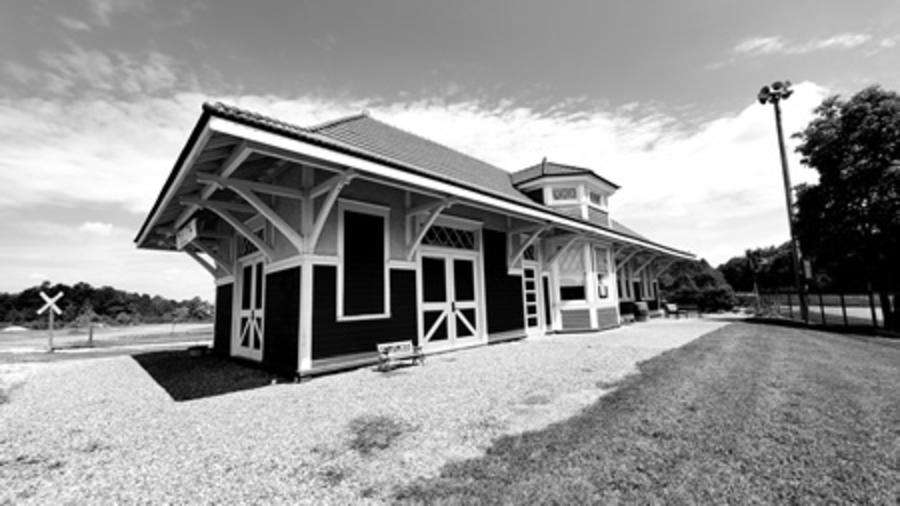The railroad has played an important role in the evolution of Sugar Hill and surrounding cities like Suwanee, Buford, Duluth and Flowery Branch. The railroad line for the modern-day Norfolk Southern Railway runs north to south through the eastern part of Sugar Hill. We are one of hundreds of cities on a continuous railroad track that goes from Louisiana to Washington, D.C.
Our name as a community supposedly developed from the legend of a wagon full of sugar overturning on a hill — the sugar had been unloaded from a train at the train depot in Buford. No doubt, the railroad has brought many good things to Sugar Hill. It has also brought tragedy. In 1908, a train wreck near Mangum’s Crossing killed Benjamin Dewberry, who was the train conductor, and his assistant, Mayson Wadkins. In late 1970, five girls from Cumming were tragically killed at Mangum’s Crossing, and there have been other deaths in the past. Like the good and bad in the inevitability of life, you might say that the railroad has helped shape the community of Sugar Hill that we all call home today. The one thing the railroad did not bring to Sugar Hill was its own train depot. A train depot could have changed the course of Sugar Hill’s history.
Cities with train depots, like Suwanee, Buford, Duluth and Flowery Branch, became boom towns in the late 1800s. Flowery Branch’s train depot became functional in 1890, while the train depots for Suwanee and Duluth were operational beginning in 1871. Cotton, leather, furniture and other manufactured goods passed through the doors of the train depot in these cities and made their way into the lives and homes of residents in the surrounding area. In addition, items like leather goods made in Buford were loaded onto trains and delivered to communities all along the eastern seaboard. Every small town and city wanted to be on a railroad line and have a train depot because the trains brought people, commerce and financial wealth to a community. Cumming, just across the Chattahoochee River in Forsyth County, was desperate for a railroad line and a train depot. In October 1915, the mayor of Cumming, Charlie Harris, invited representatives from the Georgia Chamber of Commerce to Cumming with the hope he could convince them to extend the Atlanta Northeastern Railroad line into Forsyth County. Prominent businessmen affiliated with the chamber were on a “Seeing Georgia” tour and had already visited Macon, Milledgeville, Athens and Gainesville. They were scheduled to visit Cumming but ran into white mobs as they approached a community on the outskirts of the county seat called Oscarville. A racial cleansing and a lingering legacy of racism in Forsyth County prevented a railroad line and a train depot from further consideration in Cumming.
Sugar Hill’s story is less dramatic and less controversial than Cumming’s story. There is an interesting letter posted from Lawrenceville in the June 29, 1870, edition of The Atlanta Constitution. The letter was written by James P. Simmons to the mayor of Atlanta, William Ezzard. In this letter, James states that a President Orr had informed him that he had received a letter from a Colonel Lewis inquiring about the availability of pyrite, for the purpose of producing sulphur for the manufacturing of fertilizer, on or near a railroad line in Georgia. James, who was affiliated with gold mining in Sugar Hill, writes to Mayor Ezzard:
“Both copper and iron pyrites exist in any desirable quantities in gold veins, within one and a half miles of Sugar Hill, and south of the place, on the Air-Line Railroad. I suppose many of the finest variety could be picked up among the rubbish on top of the ground. It forms a large portion of the guard which protects the veins of gold, leaving quartz ore on either side. If the company to which Colonel Lewis alludes will establish a depot at Sugar Hill, Georgia, they will have no occasion to send abroad for sulphur. I do not know where Colonel Lewis is, at present, and therefore communicate this information to you, that you may let all parties concerned know the facts.”
Local history does not tell us what happened after this letter was written by James to Mayor Ezzard. It is likely that Sugar Hill was overshadowed by industry and other economic attributes of the cities to our north and south, Buford and Suwanee. With depots being built and opened in 1871 in Duluth and Suwanee, the timing may not have been right for Sugar Hill. If you are prone to read between the lines like me, you may zero in on the statement in the letter about the unknown whereabouts of Colonel Lewis and surmise that maybe they could not find him. All we can assume is that history could have turned out very differently for Sugar Hill — how differently, we just do not know.




